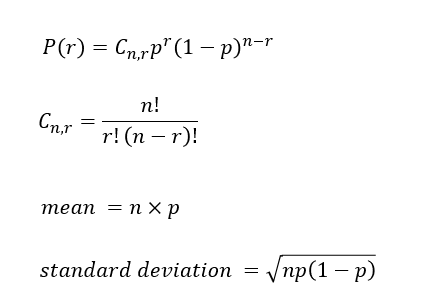Binomial Distribution
This is a discrete distribution
The binomial distribution is used when there are only two possible outcomes.
The outcomes (or successive events) are independent.
This distribution can be used when we know the probability of success.
Equations
where n is the number of trials
and r is the number of successes
and p is the probability of a success
 |
Example - Throwing a Coin
An example of when to use a binomial distribution to calculate a probability would be when you throw a coin.
When there are two equally likely, independent events, the probability is 0.5 or 50%.
You can use the BINOM.DIST function to return the probability of getting an exact number.
For this we need to use the probability distribution function so "cumulative" = False.
 |
What are the probabilities with 2 throws.
 |
What are the probabilities with 3 throws.
 |
What are the probabilities with 4 throws.
 |
What are the probabilities with 5 throws.
 |
This discrete data can be displayed on a column chart.
This column chart shows the distribution of the probabilities.
 |
You can use the BINOM.DIST function to return the probability of getting an exact number or less than.
For this we need to use the cumulative probability function so "cumulative" = True.
This chart shows the cumulative probability.
 |
You can use the BINOM.INV function to return the number of trials required for a specific amount of success.
This is the inverse of the cumulative probability.
It can tell us how many throws are required to give us a specific amount of success.
 |
Example - Rolling a Dice
Another example of when to use a binomial distribution to calculate a probability would be when you want to roll a 6.
In this case the two events are not equally likely. The probability of rolling a 6 is (1/6) and the probability of not rolling a 6 is (5/6).
© 2025 Better Solutions Limited. All Rights Reserved. © 2025 Better Solutions Limited TopPrevNext